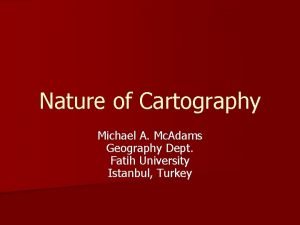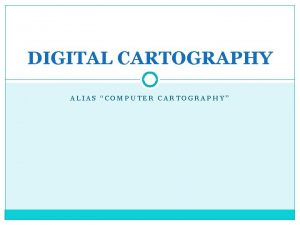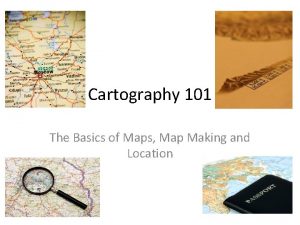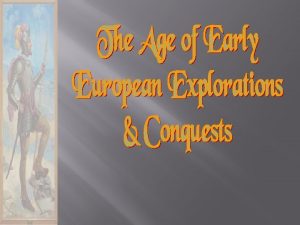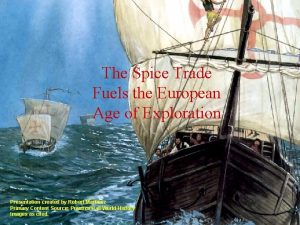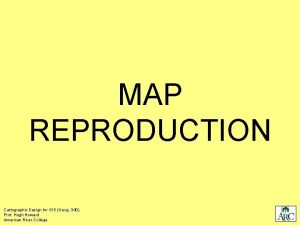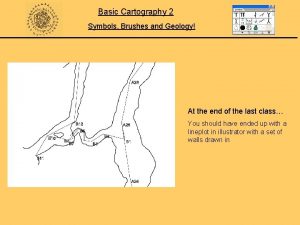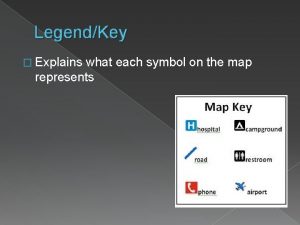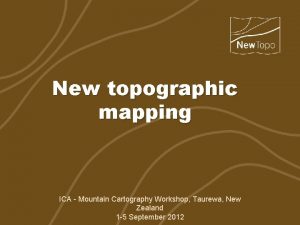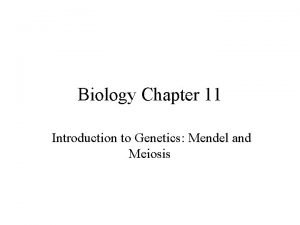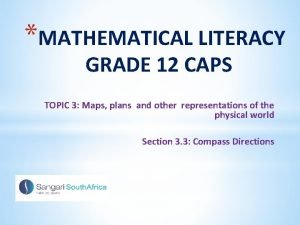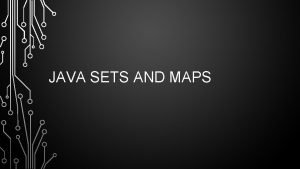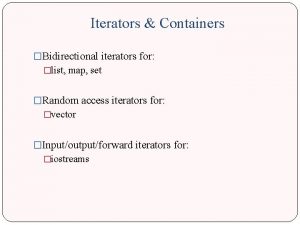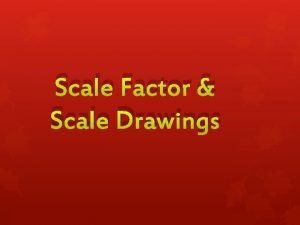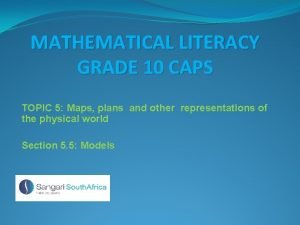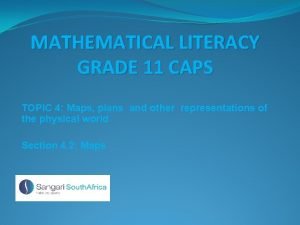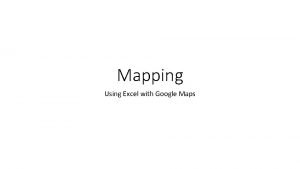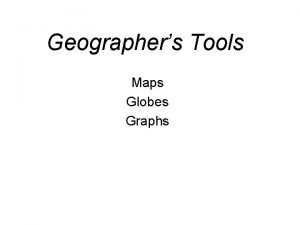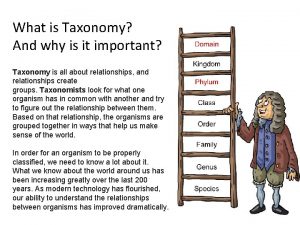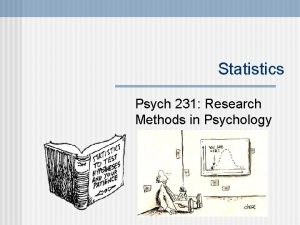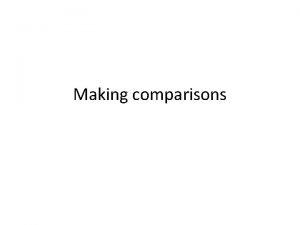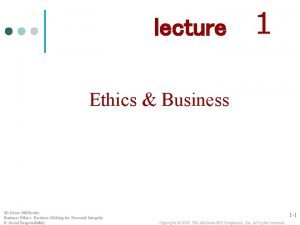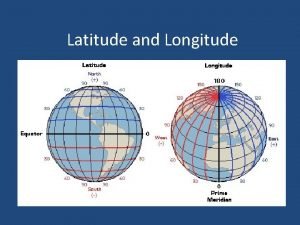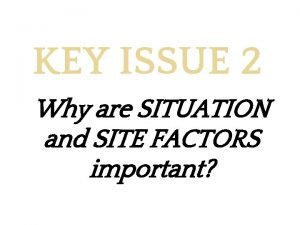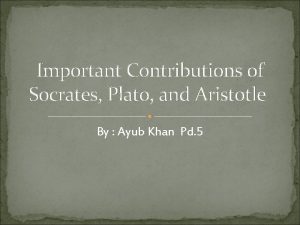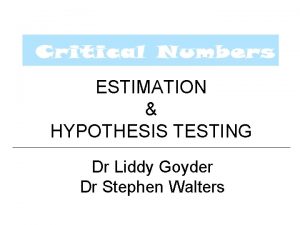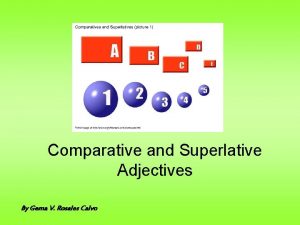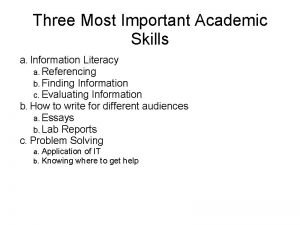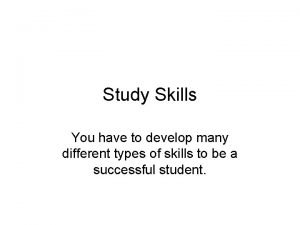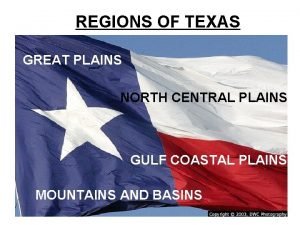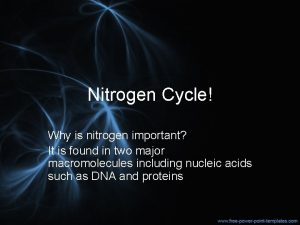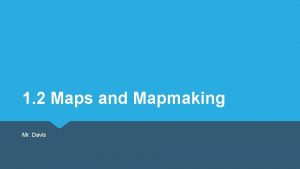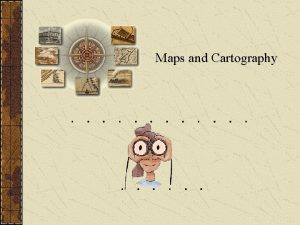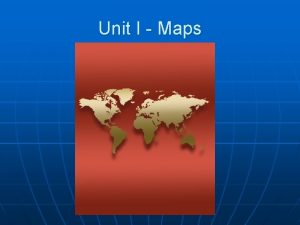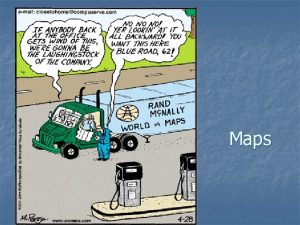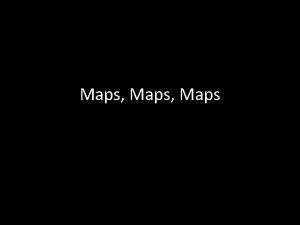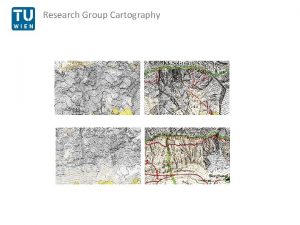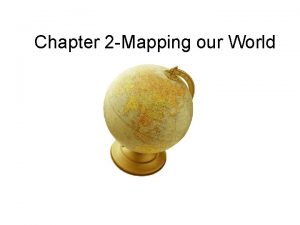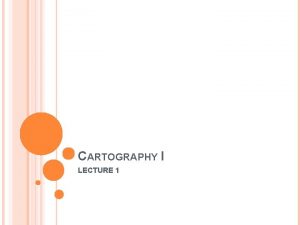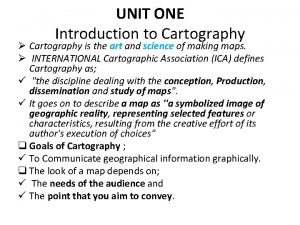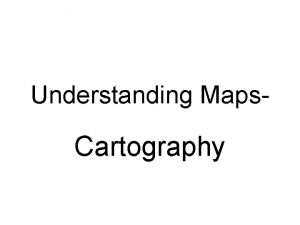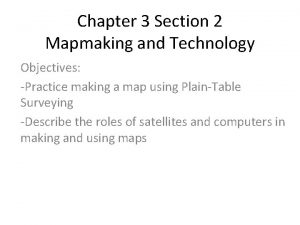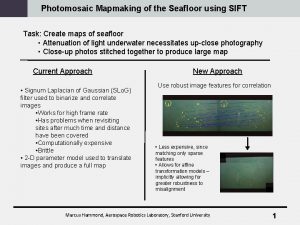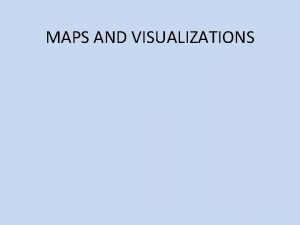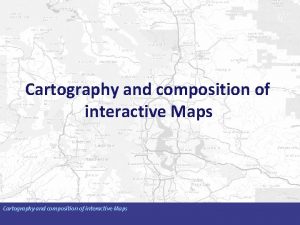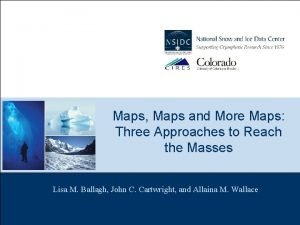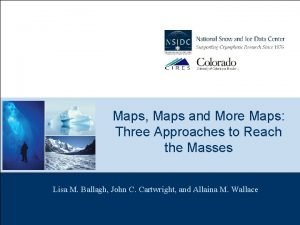Cartography Maps and Mapmaking Maps are an important


















































- Slides: 50

Cartography Maps and Mapmaking

Maps are an important tool for understanding and navigating the world around us

Defining Cartography • • • From Greek khartēs, "map“ and graphein, "write“ It is the science and study of making maps It has been an integral part of the human story for a long time, possibly up to 8, 000 years.

Why is it important? n n n To communicate geographic information in a graphic form as a digital image or a paper map To understand one’s surroundings and location Graphics are better than a description —’A picture tells a thousand words’

Maps are DIFFERENT n n Cartographers create maps for specific purposes Maps represent the context in which they were created. • time, place, culture, and regions

Map Projections n n n Robinson Globular Mercator Mollweide Hammer equal-area

Robinson Projection Pro: -size and location of main landmasses -curve of planet -easy to measure distance N/S Con: -Poles are distorted -Longitude lines do not intersect -Antarctic disproportionate (too large)

Globular Projection Pro: -proper display of poles (South) -Longitude lines intersect at Pole -Proper Antarctic size Con: -Only shows half of Globe -”squeezes” land masses and makes them look smaller (S. A. )

Mercator Projection Pro: -Easy to identify location (flat surface) -Easy to move around especially on the water (this map is used for shipping) -commonly seen in most classrooms (familiarity) Con: -Poles are distorted -Longitude lines do not intersect -cuts off landmasses (Greenland)

Mollweide Projection Pro: -most accurate for location -size of oceans are accurate -doesn’t distort size of poles Con: -hard to measure anything -visually “cut -up” -Landmasses split

Hammer Equal-area Projection Pro: -more accurate “look” -curve of planet -doesn’t distort landmasses size or location Con: -Latitude lines aren’t parallel appearance all land is on one side of globe

Why DIFFERENT? n n The way a map looks depends on the perspective of the cartographer creating it and the perspective of the viewer When it was made, where it was made, for what purpose, and with what tools all affect the outcome of a map

Mapping Tools Mapping in the western world has undergone six major phases: n Manual n Magnetic (compass -12 th century) n Mechanical (Mechanical Printing Press-16 th century) n Optical (telescope 17 th century) n Photochemical (Photography-19 th century) n Electronics (computers, GPS, GIS, 1950 present)

The first maps n n n The first known map was created in 2300 B. C. E. by the Babylonians, living in what is now modern day Iraq, and was scratched on a clay tablet. This map shows a representation of the world. By the 500 s B. C. E. , Greece was the center of scientific study and learning in the ancient world. Most people at that time thought that the Earth was flat. The Greeks, however, described a round Earth.

The Middle Ages: 400 -1450 n n Religion is more important than science. The center of Christian faith was Jerusalem, so that city often was the center of a world map. Road maps-showing the route to holy places. Portolan maps-maps for navigators.

The T-O map was common. In this map format, Jerusalem was depicted at the center and east was oriented toward the top of the map instead of true north. All maps were, of course, drawn and illustrated by hand, which made the distribution of maps extremely limited. Year circa 1450 ACE Year circa 1300 ACE Year circa 1050 ACE

Christopher Columbus n n Historic voyage in 1492 to chart a western trade route to Asia from Spain. Columbus used Ptolemy’s inaccurate maps to cross what was then thought to be a small ocean. As we know he never found Asia. Instead he ran into what is now known as the America’s The maps that were created from his voyages, changed the world forever.

The invention of printing made maps much more widely available beginning in the 15 th century. Maps were at first printed using carved wooden blocks. Post Columbus world view

1500’s Gerardus Mercator of Flanders (now Belgium) was the leading cartographer of the mid-16 th century. He developed a cylindrical projection that is still widely used for navigation charts and global maps. He published a map of the world in 1569 based on this projection. Many other map projections were soon developed. Polar View

1694 Map

The Modern Atlas As a result of countless explorations, the modern Atlas was developed. An atlas is a book containing maps of the world, named after the giant in Greek Mythology who held the world on his shoulders. Geography as we know it today, centers around the use of an Atlas.

Astrolabe n n The Greeks invented the astrolabe in the second century B. C. It is a flat metal ring marked off in degrees, with a rotating bar in the center. It was used to measure the altitude of stars, planets, and the sun. From these measurements it was possible to establish latitude.

Cross Staff n n Like an astrolabe, the cross staff measured altitude, by looking at the sun and establishing latitude. consisting essentially of a wooden rod with one or more perpendicular crosspieces free to slide along the main rod Navigators preferred using a cross staff because it was much easier to use on a rolling ship. Although it was easier to use, it became very unpopular after many navigators became blind from staring at the sun too long.

Sextant n n n In 1757 a new tool called a sextant was introduced. The sextant derived its name from the fact that it could measure up to sixty degrees. An instrument used to determine the position of a ship or airplane by measuring the positions of the stars and sun.

Compass n n A magnetic needle mounted on what is known as a compass rose Because of the earth’s magnetic fields, the compass always points North Aiding explorers in navigation Considered the greatest invention in the world of exploration

The Birth of Modern Mapmaking. Surveying n Surveying- the science and art of determining the relative positions of points above, on, or beneath the surface of the earth New techniques in France in the late 1700 s greatly improved the art of mapmaking. n n By measuring angles and distances between various points, surveyors can plot a picture of the part of the Earth they are studying. They can learn its shape, size and position. Based on the new art of surveying, an accurate map of the planet was finally developed in 1791.

Mapmaking Has Changed the World Surveying has lead to many new types of maps over time: Accurate maps of cities Accurate maps of roads Accurate maps for traveling on the ocean Even in the air…. . such as…. .

AERONAUTICAL MAP

The Future of Mapmaking

Sonar n n n A new device known as Sonar was invented during World War II. Sonar involves the use of sound waves to detect objects. A sound wave is sent to an object, and the time it takes to return determines distance. In relation to sonar, we are talking about water depth. Many consider the ocean to be the last great frontier.

The use of sonar has lead to very accurate maps of our oceans and waterways.

Satellites n n n Satellite: manmade instrument placed in orbit around the earth or moon or another planet in order to collect information or for communication. The first satellite was launched into space in 1957 by the former Soviet Union. Satellites send signals to track location • Global Positioning System (GPS)

GPS n Global Positioning System • a navigational system involving satellites and computers that can determine the latitude and longitude of a receiver (device) on Earth by computing the time difference for signals from different satellites to reach the receiver • a navigational system that uses signals from satellites to tell you where you are and to give you directions to other places

GIS n n A geographic information system (GIS) integrates hardware, software, and data for capturing, managing, analyzing, and displaying all forms of geographically referenced information. It digitally makes and "manipulates" spatial areas

GIS plays an important role n n GIS allows us to view data in many ways that reveal relationships, patterns, and trends in the form of maps, globes, reports, and charts. Police and fire departments may use GISs to locate landmarks and hazards, plot destinations, and design emergency routes.

CAM n Computer Aided Mapping: Software with the capability of generating standard mapping functions. In contrast to GIS, it can not analyze or process a database.

The Future of Mapmaking Satellite Imagery

Data gathered from satellites provides 4 distinct types of Maps Topographical Map: Shows elevation and contour

Resource Map: Location of natural resources, rivers, lakes, etc

Place Map: Shows location (road or city)

Movement Map of Beijing China

Weather Map: Shows weather fronts, temperature trends, etc

Physical Maps n n Show what the land itself looks like, identifying physical features such as mountain ranges and rivers. These maps use different colors to represent different elevations of land.

Physical Map of USA

Political Map n n Show an area is divided into countries, states, provinces or other units. This maps use different colors to represent countries, and capital cities are often shown with a special star symbol.

Political Map of India

Distribution maps- show where something can be found Distribution Map of Rhino’s in Africa

Special-Purpose Map n n n A general purpose map gives you location of various places and uses traditional symbols. A special purpose map focuses on a certain detail. For example: topography, climate or district. A special purpose map is one made for a specific need, such as showing waterways or railroads or bike paths.

Special-Purpose Map: Fire Ecology

Evaluation Ø In your best words, describe what a map means to you. Ø Name different types of maps you may come across. Ø What is a compass used for? A legend? Ø Why are maps important? Ø Who designs maps? How do you think this is done?
 Insidan region jh
Insidan region jh Nature of cartography
Nature of cartography Digital cartography definition
Digital cartography definition Cartography basics
Cartography basics Maps before 1492
Maps before 1492 Cartography
Cartography What is map reproduction
What is map reproduction Cartography brushes
Cartography brushes What kind of map
What kind of map Applied cartography
Applied cartography Mountain cartography
Mountain cartography Reittihaku google maps
Reittihaku google maps Newspaper article format
Newspaper article format Inverted pyramid in news writing
Inverted pyramid in news writing Least important to most important
Least important to most important Floor plan grade 12 maths literacy
Floor plan grade 12 maths literacy Types of maps in mathematical literacy grade 12
Types of maps in mathematical literacy grade 12 Section 11-3 exploring mendelian genetics answer key
Section 11-3 exploring mendelian genetics answer key Section 11-5 linkage and gene maps
Section 11-5 linkage and gene maps Who did this
Who did this Section 11-5 linkage and gene maps answer key
Section 11-5 linkage and gene maps answer key Different types of maps in maths lit
Different types of maps in maths lit Sets and maps java
Sets and maps java Maps and sets support bidirectional iterators.
Maps and sets support bidirectional iterators. Old scale drawing
Old scale drawing Maps, plans and other representations of the physical world
Maps, plans and other representations of the physical world Slide todoc.com
Slide todoc.com Elevation map maths lit
Elevation map maths lit Excel and google maps
Excel and google maps Maps globes and graphs
Maps globes and graphs Dumbking plant
Dumbking plant Shat is passover
Shat is passover Statistic
Statistic Act 4 scene 4-5 romeo and juliet
Act 4 scene 4-5 romeo and juliet Superlative delicious
Superlative delicious What is ethics and why is it important
What is ethics and why is it important Imaginary horizontal lines around the earth
Imaginary horizontal lines around the earth Key issue 2 why are situation and site factors important
Key issue 2 why are situation and site factors important How to calculate fluid intake and output
How to calculate fluid intake and output Aristotle contribution
Aristotle contribution Null hypothesis example
Null hypothesis example Romeo and juliet quotes: act 1
Romeo and juliet quotes: act 1 Why is it important to test installed equipment and devices
Why is it important to test installed equipment and devices Comparatives adjectives bad
Comparatives adjectives bad Milady chapter 23
Milady chapter 23 What are study skills and why are they important
What are study skills and why are they important What are study skills and why are they important
What are study skills and why are they important North central plains region major cities
North central plains region major cities What is research philosophy and why is it important
What is research philosophy and why is it important Macromolecule with nitrogen
Macromolecule with nitrogen What is email etiquette and why is it important
What is email etiquette and why is it important

